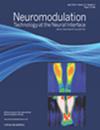Effects of Pulsed Radiofrequency Duration in Patients With Chronic Lumbosacral Radicular Pain: A Randomized Double-Blind Study
IF 3.2
3区 医学
Q2 CLINICAL NEUROLOGY
引用次数: 0
Abstract
Objectives
We hypothesized that the duration of pulsed radiofrequency (PRF) application may affect the effectiveness of PRF in patients with chronic lumbosacral radicular pain (LRP).
Materials and Methods
In this prospective, double-blind, randomized study, 68 patients were randomly allocated to two groups: a 6-minute group, in which PRF was applied at 42 °C for 2 minutes followed by a 2-minute pause, repeated three times; and a 12-minute group, with a continuous application at 42 °C for 12 minutes. The total application time in each group was equal. After PRF, 2 to 3 mL of 1% lidocaine with 5 mg of dexamethasone was injected. The primary outcome was the intensity of leg pain measured using a numerical rating scale (NRS) three months after the procedure. The secondary outcomes were intensities of leg and back pain, the Oswestry Disability Index (ODI), the Medication Quantification Scale III (MQS), the Global Perceived Effect of Satisfaction (GPES), and the incidence of adverse events during follow-up. Primary and secondary outcomes were analyzed using a linear mixed-effect model in the modified intention-to-treat population.
Results
Each group comprised 34 patients. Three patients in each group did not receive the allocated intervention owing to alleviation of pain. The estimated NRS mean of leg pain at three months was 4.0 (95% CI, 3.2–4.9) and 4.5 (95% CI, 3.6–5.4) in the 6- and 12-minute groups, respectively, with no significant difference between groups (estimated mean difference, −0.5; 95% CI, −1.8 to 0.8; p = 0.436). Regarding the intensities of leg and back pain, ODI, MQS, and GPES, there was no significant difference between the two groups except for GPES at six months. No adverse events were observed in the groups.
Conclusions
Among patients with chronic LRP, a prolonged PRF application of 12 minutes, compared with 6 minutes, caused no significant difference in leg pain intensity.
Clinical Trial Registration
The Clinicaltrials.gov registration number under the Clinical Trial Registry of Korea for the study is KCT0003850; https://cris.nih.go.kr.
脉冲射频持续时间对慢性腰骶部疼痛患者的影响:一项随机双盲研究。
目的:我们假设脉冲射频(PRF)应用的持续时间可能会影响慢性腰骶部疼痛(LRP)患者的疗效:我们假设脉冲射频(PRF)应用的持续时间可能会影响脉冲射频对慢性腰骶根性疼痛(LRP)患者的疗效:在这项前瞻性、双盲、随机研究中,68 名患者被随机分配到两组:一组为 6 分钟组,在 42 ℃ 下应用脉冲射频 2 分钟,然后暂停 2 分钟,重复三次;另一组为 12 分钟组,在 42 ℃ 下持续应用 12 分钟。每组的总施用时间相同。PRF 后,注射 2 至 3 毫升 1%利多卡因和 5 毫克地塞米松。主要结果是治疗三个月后使用数字评分量表(NRS)测量的腿部疼痛强度。次要结果是腿部和背部疼痛强度、Oswestry 残疾指数(ODI)、药物量化量表 III(MQS)、全球满意度感知效果(GPES)以及随访期间不良事件的发生率。采用线性混合效应模型对主要和次要结果进行分析:每组有 34 名患者。每组有三名患者因疼痛减轻而未接受所分配的干预。三个月后,6 分钟组和 12 分钟组的腿部疼痛 NRS 平均值估计分别为 4.0(95% CI,3.2-4.9)和 4.5(95% CI,3.6-5.4),组间差异不显著(估计平均值差异为-0.5;95% CI,-1.8 至 0.8;P = 0.436)。在腿痛和背痛的强度、ODI、MQS 和 GPES 方面,除 6 个月时的 GPES 外,两组间无显著差异。两组患者均未出现不良反应:结论:在慢性LRP患者中,与6分钟的PRF治疗相比,12分钟的PRF治疗对腿部疼痛强度的影响无明显差异:该研究在韩国临床试验注册中心的 Clinicaltrials.gov 注册号为 KCT0003850;https://cris.nih.go.kr。
本文章由计算机程序翻译,如有差异,请以英文原文为准。
求助全文
约1分钟内获得全文
求助全文
来源期刊

Neuromodulation
医学-临床神经学
CiteScore
6.40
自引率
3.60%
发文量
978
审稿时长
54 days
期刊介绍:
Neuromodulation: Technology at the Neural Interface is the preeminent journal in the area of neuromodulation, providing our readership with the state of the art clinical, translational, and basic science research in the field. For clinicians, engineers, scientists and members of the biotechnology industry alike, Neuromodulation provides timely and rigorously peer-reviewed articles on the technology, science, and clinical application of devices that interface with the nervous system to treat disease and improve function.
 求助内容:
求助内容: 应助结果提醒方式:
应助结果提醒方式:


